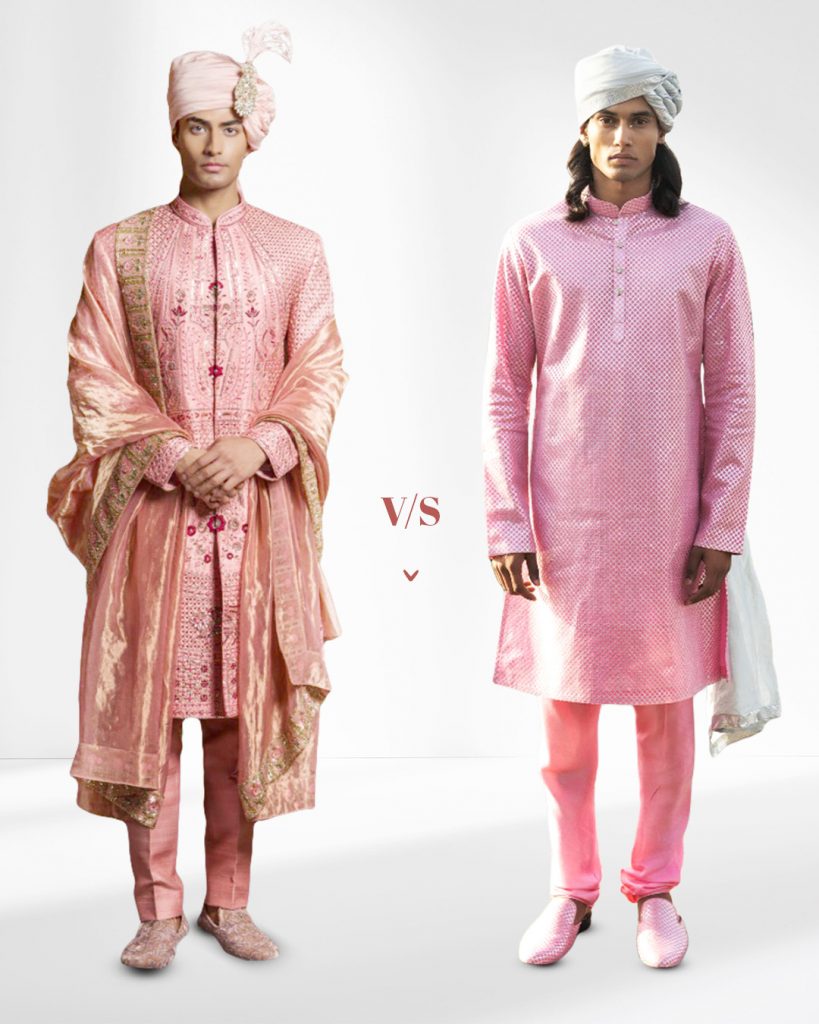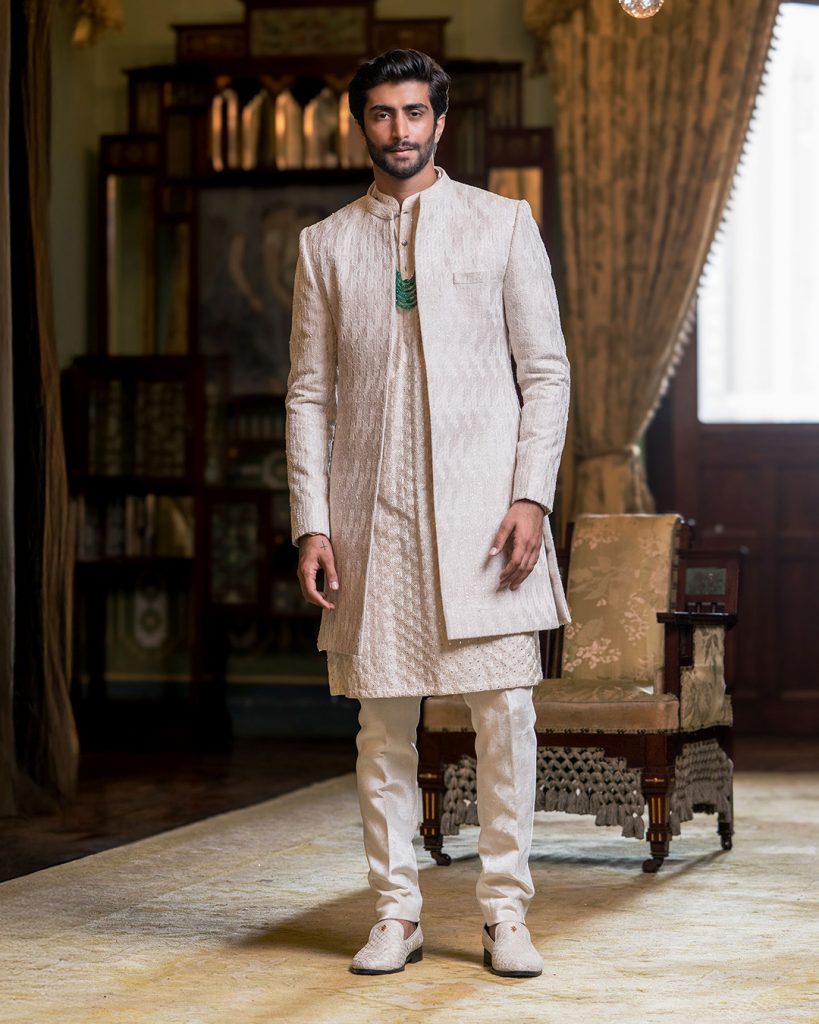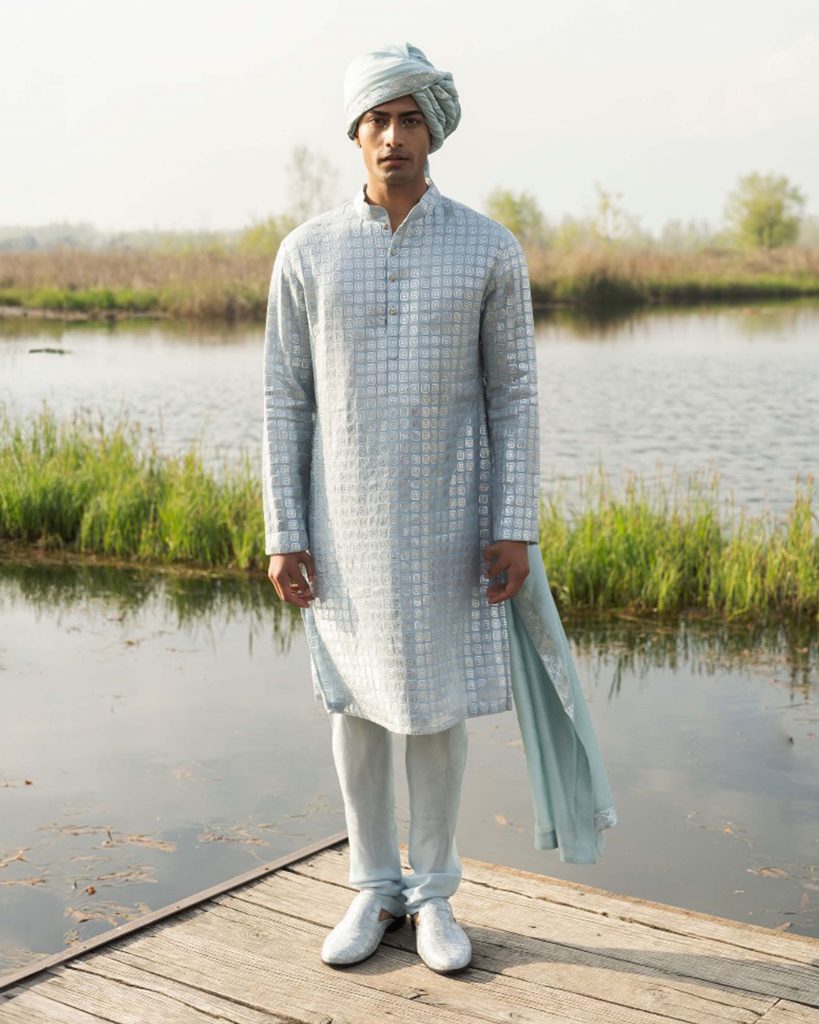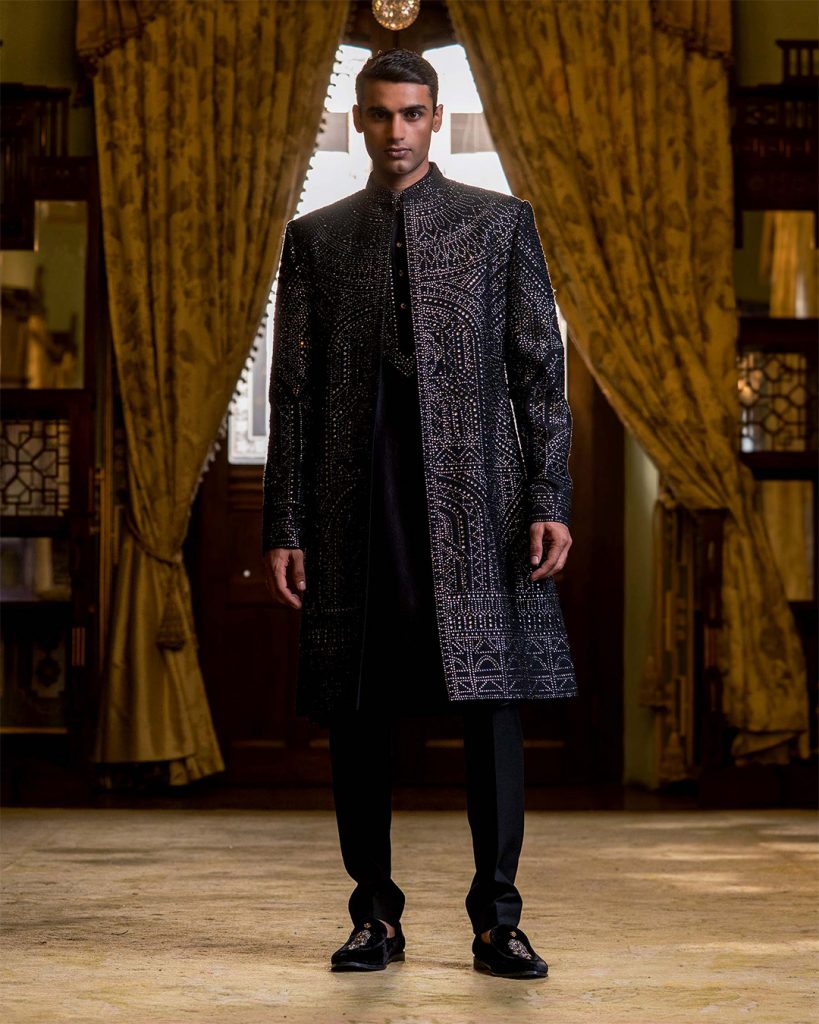
The regal grandeur of the sherwani is unmatched by any other men’s traditional attire. Grooms for ages have been relying on this opulent garment to look like royalty on their special day. The elaborate outfit is tailored from premium fabrics, featuring structured silhouettes, often adorned with intricate embroidery to suit celebratory occasions such as weddings and festivals.
What is a Sherwani?

A sherwani is a traditional South Asian men’s garment worn on special occasions such as weddings and festive occasions. It can be defined as a long coat with a standing collar, made from luxurious fabrics, featuring intricate embroidery and embellishments.
The elaborate outfit originated in the 19th century and was associated with Muslim aristocracy during the British era. The sherwani takes its inspiration from the chapkan, a Persian cape. It later evolved to resemble an Indian angrakha and was further developed into the current sherwani designs with buttons.
In India, the sherwani was worn by Mughal nobles of Northern India and was gradually adopted by royals and aristocrats of other regions. Gradually, the silhouette found its way out of the palaces and was adopted by the general population, often worn on special occasions only.
Key Characteristics & Styles:
Length: Generally, the ideal length of a wedding sherwani should end just below the knee to achieve the ultimate traditional look. This length looks elegant and sophisticated on everyone, despite their build. However, the length can be altered based on personal preferences. You can either opt for a style that has a longer hemline or experiment with shorter ones.
Fabric: Sherwanis are meant to be worn on special occasions and are thus made from rich fabrics, such as brocade, raw silk, silk, velvet, and jacquard. Each fabric comprises unique qualities, adding to the look, feel, and comfort of the sherwani. Some of the most popular choices are silk, known for its regal appearance and sheen, and velvet for its opulent look and feel.
Embellishments: More than embellishments, sherwanis are often adorned with intricate embroidery patterns to add a regal look to the attire. Popular needlework techniques, such as Zardozi, Resham, and Aari, are some of the popular embroidery techniques used on reception sherwanis for a refined and polished look.
However, modern grooms are shifting their preferences from the classic embroidered sherwanis to heavily embellished sherwanis, featuring sequins, beads, and crystal detailing. These embellishments add just the right amount of bling, highlighting the design of the sherwani and adding to its visual appeal.
Fit: Sherwanis are available in different fits, including the traditional straight-cut, the flared A-line, the longer Achkan, and the Indo-Western silhouette with contemporary cuts. Other popular options include the sleek Jodhpuri and the regal Anarkali with a flared bottom.
Common Styles:
Achkan: The achkan is a knee-length or longer coat-like garment that fits snugly and features a buttoned front opening. It features a tapered silhouette with a slight flare at the bottom. Achkans are suitable for both formal and festive occasions, as they are made of lightweight fabrics and often feature minimal embroidery and embellishments. You can read more about the differences between achkan and sherwani in our blog.
Jodhpuri: A Jodhpuri sherwani is an Indian outfit originating from the Jodhpur region of Rajasthan. It features a long coat that extends below the knees, has a Nehru-style collar, and is often made from luxurious fabrics like silk, velvet, brocade, and jacquard. A Jodhpuri sherwani is often worn with churidar pants, a salwar, or dhotis for a cohesive look.
Indo-Western: Indo-Western sherwani designs are a hit among modern-day grooms for their special day, as these combine traditional Indian aesthetics with western design elements, such as modern tailoring, asymmetrical cuts, and unique draping, to create a sophisticated look.
Pakistani Sherwani: A Pakistani sherwani is similar to a regular sherwani with small discrepancies. For instance, a Pakistani sherwani is slightly longer and often features heavier embroidery. It is paired with a kurta, churidar pants, and a dupatta.
Ideal Occasions for Sherwani:
For decades, sherwanis have been the ultimate wedding attire for Indian men, and they continue to rule men’s traditional wardrobes. Whether it is a wedding, formal event, gala, reception, or an opulent festive celebration, sherwanis offer the right amount of sophistication and style.
What is a Kurta?

A men’s kurta is a long and loose tunic, often with long sleeves, a buttoned front in the upper one-third part, and side slits on both sides. When it comes to kurta vs sherwani, unlike sherwanis, kurtas impart a casual vibe and are a suitable dressing option for low-key events and small parties. Kurtas are made from lightweight, breathable fabrics such as cotton, linen, and silk for ultimate comfort.
This traditional designer wear for men finds its origin in Central Asia and Persia. It is suggested that kurtas were introduced in India during the Mughal era, and over the years, they evolved to reach the modern-day aesthetic. Today, kurtas are worn by Indian men for all types of occasions to look polished and put-together.
Key Characteristics & Styles:
Length: Men’s kurtas can be explored in different lengths, depending on fashion preferences. Some of the most popular lengths for men include short kurtas that fall above the knees, mid-length kurtas that land on the knees, and long kurtas that reach the mid-calf length.
Fabric: Kurtas are often made with lightweight and breathable fabrics, such as cotton, linen, and silk. But depending on the occasion, men’s kurtas can be explored in a variety of other fabrics such as brocade, velvet, and jacquard. While lighter fabrics are suitable for everyday wear and small parties and get-togethers, heavier fabrics are more suitable for celebratory occasions, such as weddings and reception parties.
Embellishments: Men’s kurtas can be explored in different variations, ranging from plain solids to heavily embellished. Depending on your sartorial choices and the occasion, you can choose a suitable kurta. For casual, day-to-day wear, solid-hued or printed kurtas are the best pick. However, for festive occasions and weddings, kurtas with intricate embroidery and subtle embellishments are more apt.
Fit: Men’s kurtas always feature a loose and comfortable fit. This means that you should be able to move your hands and body without feeling restricted. The shoulder seams should sit aligned with the shoulders, and the sleeves should end at the wrists or slightly below the wrists. The length of the kurta may vary depending on personal preferences.
Common Styles:
Some of the common kurta styles for men are as follows:
Pathani Kurta: A Pathani kurta is marked by a shirt collar and buttoned cuffs. It is slightly longer and is often paired with a Pathani pyjama or salwar for a cohesive look.
Lucknowi Kurta: A Lucknowi kurta features the traditional chikankari embroidery, a delicate hand-embroidery that features intricate motifs. This thread embroidery finds its roots in the Mughal era, and it combines traditional craftsmanship with contemporary aesthetics.
Punjabi Kurta: A Punjabi kurta features a straight-cut silhouette and is paired with a pyjama. Compared to a regular kurta, this one offers a slimmer fit and often has chest pockets with flaps on both sides.
Asymmetrical Kurta: Asymmetrical kurtas are a modern rendition of the traditional men’s kurtas and feature an asymmetrical hemline. These are more appropriate for casual wear and are perfect for those who want to make a style statement.
Ideal Occasions for Kurta:
Kurtas can be worn and styled for numerous types of occasions, including weddings, family gatherings, casual outings, office parties, festive get-togethers, etc. Depending on the formality of the event, a suitable kurta can be picked.
Sherwani vs. Kurta: Difference Between Sherwani and Kurta
| Feature | Sherwani | Kurta |
| Formality | Highly formal | Casual to semi-formal |
| Length | Longer (knee-length or below) | Shorter (waist to knee-length) |
| Fit | Structured, tailored | Loose, comfortable |
| Fabric | Rich, heavy (silk, brocade, velvet) | Lighter, breathable (cotton, linen, silk) |
| Embellishment | Heavy embroidery, ornate | Minimal to moderate embroidery/prints |
| Occasion | Weddings, grand formal events | Daily wear, casual, semi-formal events |
Choosing the Right Attire: Factors to Consider

Occasion: Select your ensemble to match the specific event’s requirements. Solid–hued or printed cotton kurtas for daily wear and casual occasions. For celebratory events, such as weddings, pick an embroidered or embellished kurta in brighter hues. A sherwani is best suited for grooms, as it is an elaborate attire.
Comfort: For maximum comfort, pay special attention to the fabric of the attire. During the summer, lightweight and breathable fabrics like cotton are the best picks. However, for colder months, consider thicker fabrics like velvet and brocade.
Personal Style: There are several differences between a kurta and a sherwani. But no matter what style you pick, the chosen attire should suit your fashion preferences and style. Do not rely too much on ongoing trends, and stick to your sartorial instincts.
Accessories: Kurtas are best styled with Nehru jackets and stoles for a fancier look. Sherwanis, on the other hand, should be styled with a turban, stole, and mojris for a complete traditional look.
Conclusion
Both sherwanis and kurtas make up the backbone of Indian traditional wear for men and are an indispensable part of the Indian culture. However, the outfit you pick really depends on the occasion you are headed to and your personal choice. Do you prefer a subdued, minimal look or an elaborately extravagant outfit? Consider all these factors before finalising your suitable attire, and you are bound to make the perfect choice.